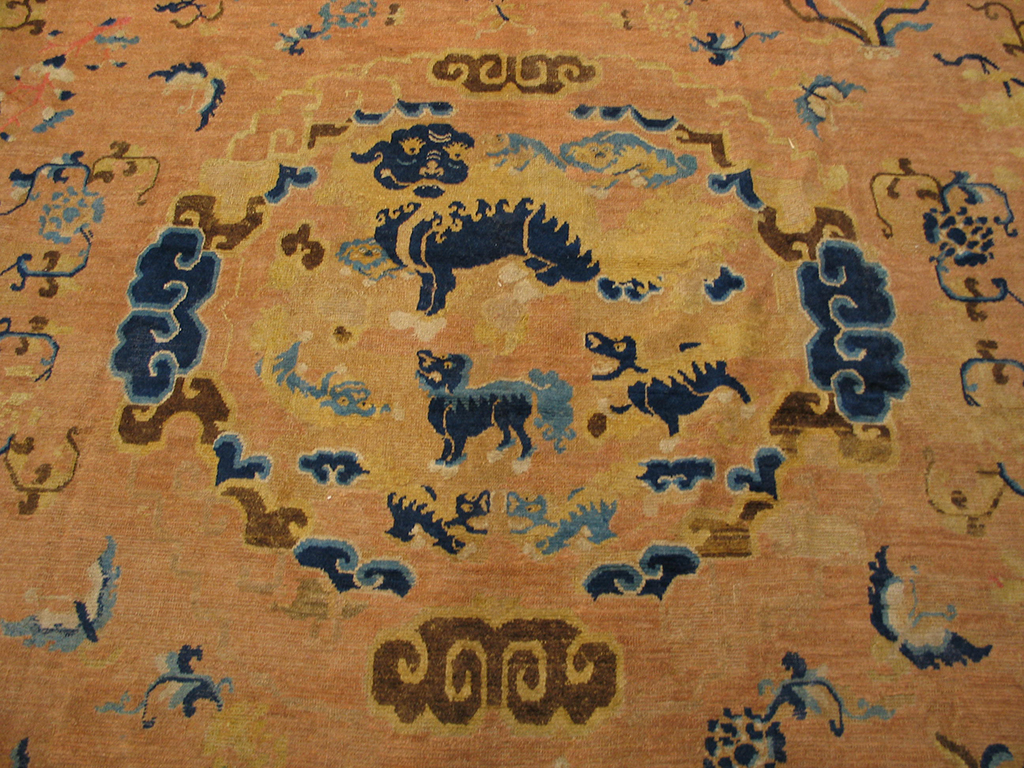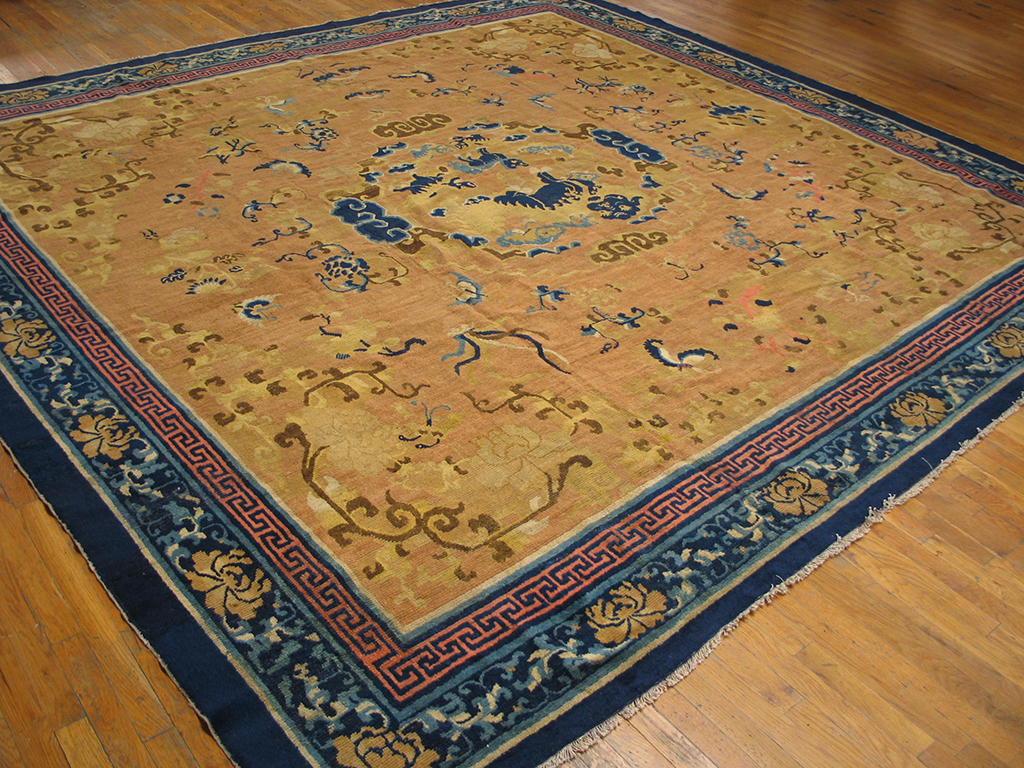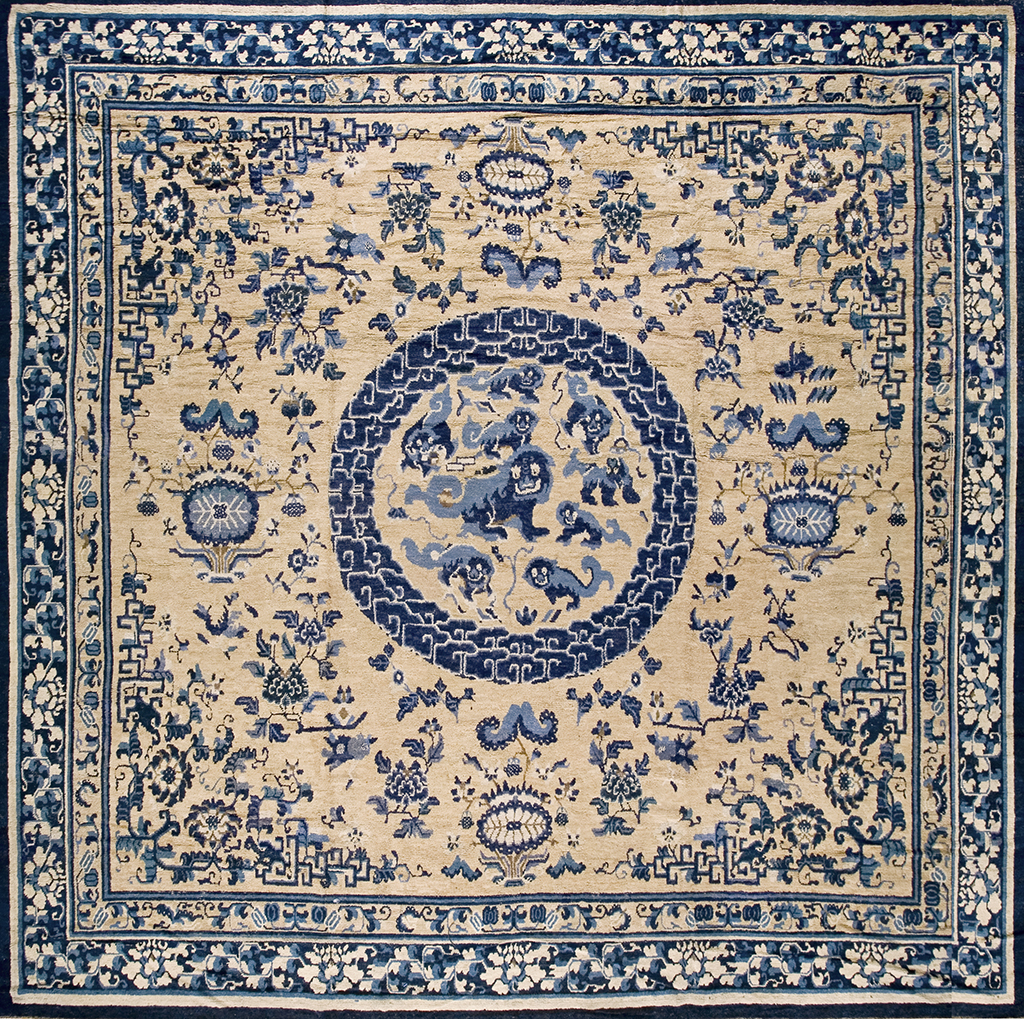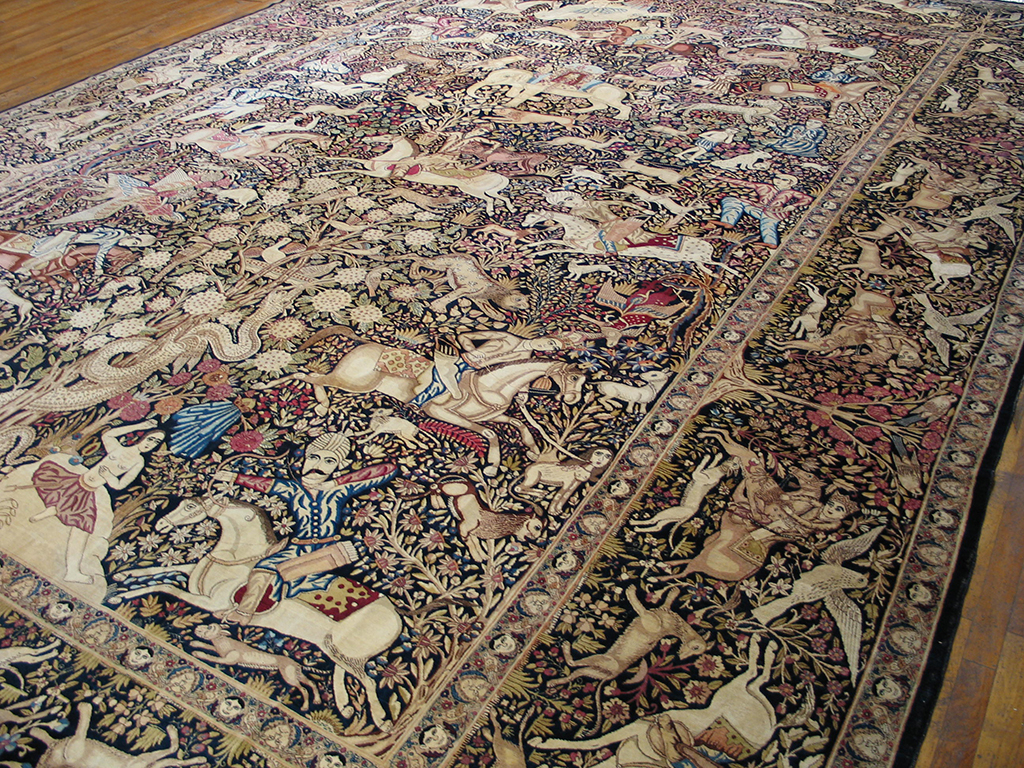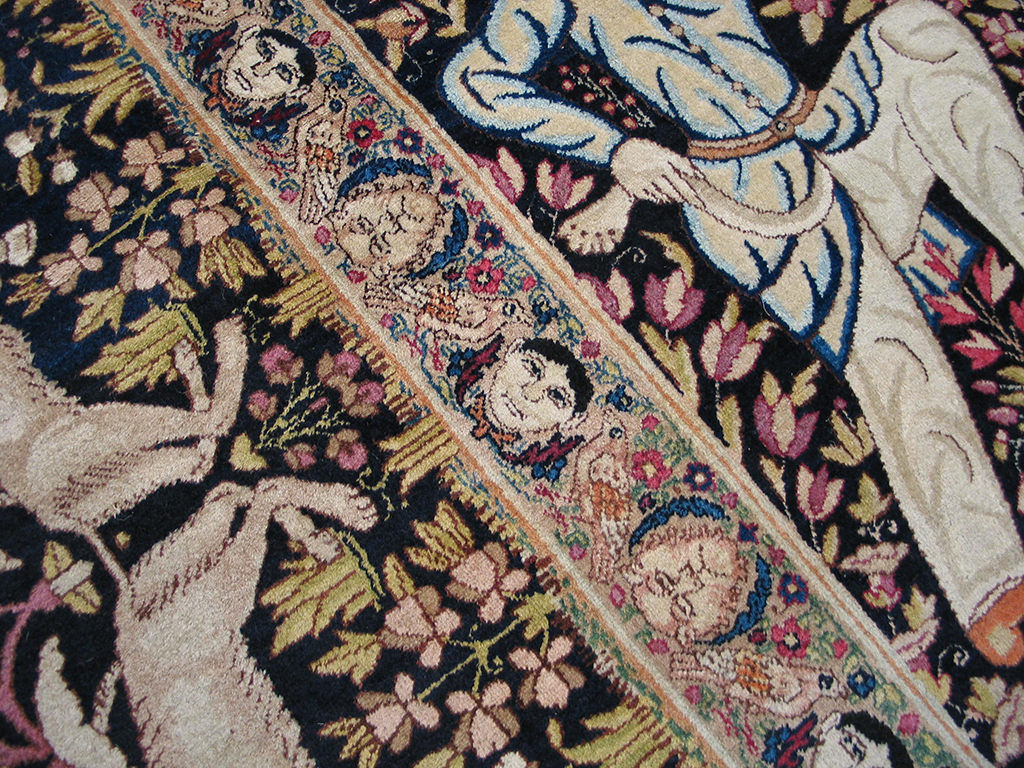
#20947
Tapestry
10’ 4” x 17’ 8”
Wool and Silk pattern wefts on wool warp; warps/inch.
Beauvais, French Royal Tapestry Workshop under the direction of Nicolas Besnier and Jean – Baptiste Oudry (1734-1753), or A.C. Charron (1753-1780).
Designed by Francois Boucher
Subject: La Musique (Music) No. 9 of a set of 14 panels “Fetes Italiennes” or “Italian Scenes”, showing peasants and working-class folk with a few panels displaying members of the upper classes at play. “Music” is one of these.
Boucher’s original drawings for Music (and other tapestries as well) are in The Stadelkunst Institute (Frankfort, Germany), and in a private collection in Paris.
This was Boucher’s first tapestry design commission for the Beauvais factory. His other work includes the “Nobles Pastorales” series in the 1750’s.
There is no complete set of all 14 tapestries extant and no complete set was ever woven for a single client. The present panel lacks a mark in the outer plain blue border, now excised and replaced by a later restoration. The mark would have given the place (Beauvais) and either Besnier’s or Charron’s name.
The entire set of the “Fetes Italiennes” comprises:
- Le Operateur (The Charlatan)
- La Bohemienne (The Gypsy Fortune Teller)
- Les Pecheuses (The Fishing Girls)
- Les Chasseurs (The Hunting Boys)
- La Curiosite (Curiosity)
- Les Filles aux Raisins (Girls Gathering Grapes)
- La Danse (Dance)
- La Collation (The Luncheon)
- La Musique (Music)
- Le Jardinier (The Gardener)
- La Bergere
- La Cabaretier (The Inn Keeper)
- Le Perroquet (The Parrot)
- Le Marchant d’Oeufs (The Eggseller)
Of the Fetes Italiennes, No. 9, Music was executed eleven times: 1745, 1746, 1750 4 times, 1751 twice, 1753 twice. 1754.
There was a partial set of six panels including Music sold in Paris, M.X…Collection, Galerie Georges Petit, 23.5.27 and all are illustrated in the catalogue. The version of Music, lot 2 is shorter, 3.15 m. height, 2.90 m. long.
Only the right half of the whole composition appears, ending just to the left of the outstretched arm of the cellist in the center. The trellised garden ledge and tower, along with two figures are not present. Our panel is 8’ 8” longer than the 1927 example. The double guilloche border is common to both versions and is one of the standard Beauvais borders used as late as 1774. It also appears in the set in N.Y.
The sizes and subjects of the X … Collection pieces are as follows:
Dance 3.10 m x 4.75 m
Music 3.15 m x 2.90 m
Hunters 3.10 m x 2.75 m
Fishers 3.10 m x 2.0 m
Entrefenetre 3.05 m x 1.45 m
Entrefenetre 3.10 m x 1.40 m
Music is therefore, in its original form, the largest of the set.
The 1927 catalogue notes that there are longer replicas of Music with the additional personages to left. This variation and reduction of scenes is not uncommon and because of the weaving process, here from right to left, is easy to accomplish. The process proceeds horizontally, and the weavers can start or stop at any point in the cartoon.
Panel no. 9, Music, was woven in:
1745 for M. Gautier (nos. 7, 8, 9)
1746 for General Sale (nos. 7-10)
1750 for M. d’Aremberg (nos. 7-10)
1750 for Sueden (nos. 7, 9, 10)
1750 for M. Lalande (nos. 2, 8-10)
1750 for General Sale (nos. 1-4, 7-10)
1751 for M. Thibault (nos.1,3,4,7,9,10)
1751 for M. de Vermonoye (nos.7-9)
1753 for M. Duvocel (nos. 9-11)
1753 for Mme. Geoffrin (nos. 4,7-10)
1754 for M. Marchant (nos. 3,4,9,11)
Since our panel employs the full cartoon, it was likely one of the earlier editions, possibly as early as 1745 or 1746.
The Metropolitan Museum of Art in NY has 9 pieces including one duplicate slightly expanded to left. Music is not included. Standen is in error in stating that the Met’s set is complete.
The series is internally stylistically coherent and some of the same figures and scenic elements are reused. For example, Music and The Gardener (no. 10) both employ the same trellised garden walls and the female in profile in The Gardener reappears almost exactly as the central girl close to the cellist in Music. The putti riding dolphins in the fountain at the right of Music reappears in other examples of Boucher’s work. The rustic leaning on the ledge is of the same laborer social class as The Gardener in no. 10. The dimensions of “Music” are the greatest for any of the series and although it is unknown how many of the eleven editions of this design were produced in the fully extended large format, it was clearly a special creation. No armorial device was ever present. Sets were often split and recombined, and it is not possible to trace all the editions on individual panels.










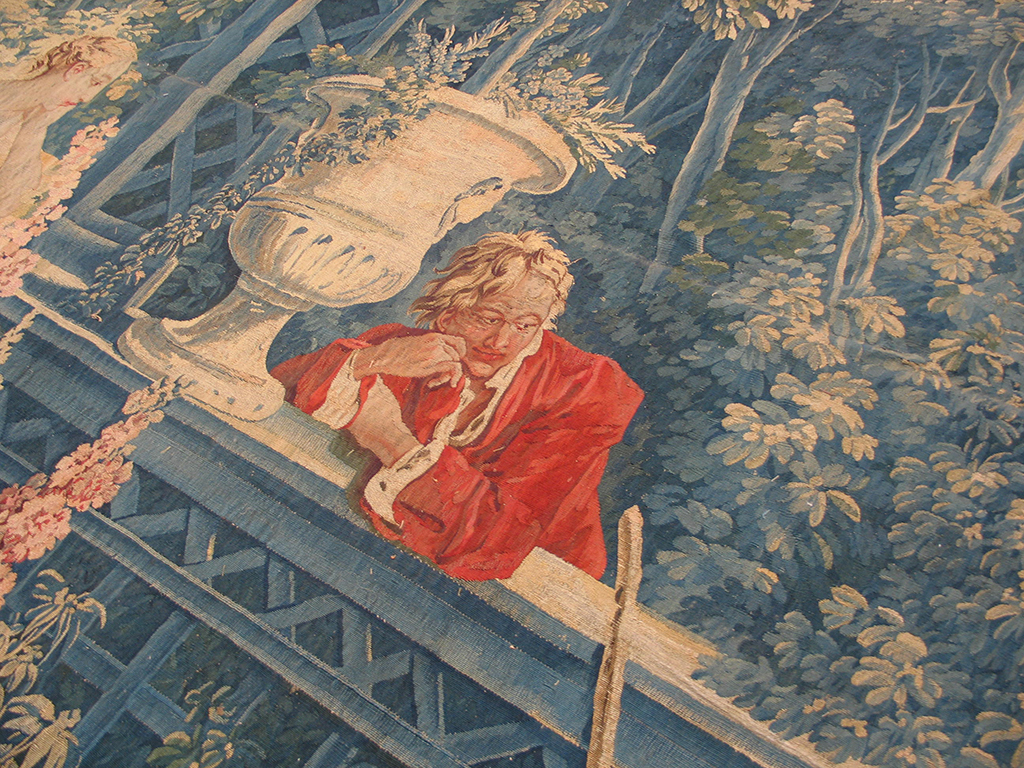
Condition:
There has been selective color fading, but the reds have held up very well. The condition is quite good and splitting is minor. The silk has been replaced. The borders have been shaved on the edges with the loss of any marks in the plain dark slip. The plain strip has been replaced at the ends.
References:
- Jules Badin, Le Manufacture de Tapisseriede Beauvais, Paris, 1909. The full chronology of all series is given, and it is still the essential primary source work.
- Edith Standen, European Post-Medieval Tapestries in the Metropolitan Museum of Art, NY, 2 Vols. Italian Village Scenes (Fetes Italiennes), No. 78 pp 507-533.
- Trois Siecles de Tapisserie de Beauvais, Beauvais, 1964.




